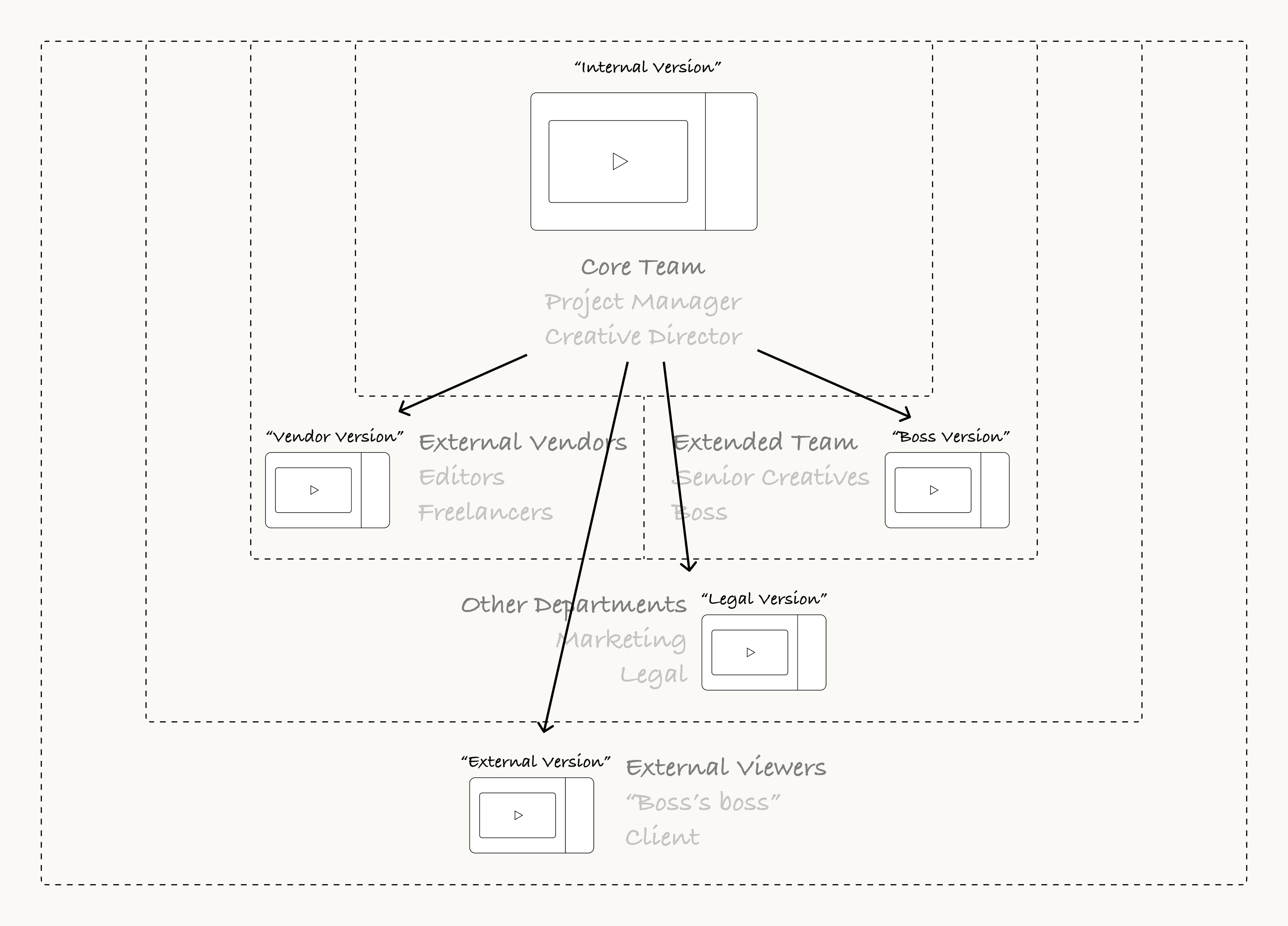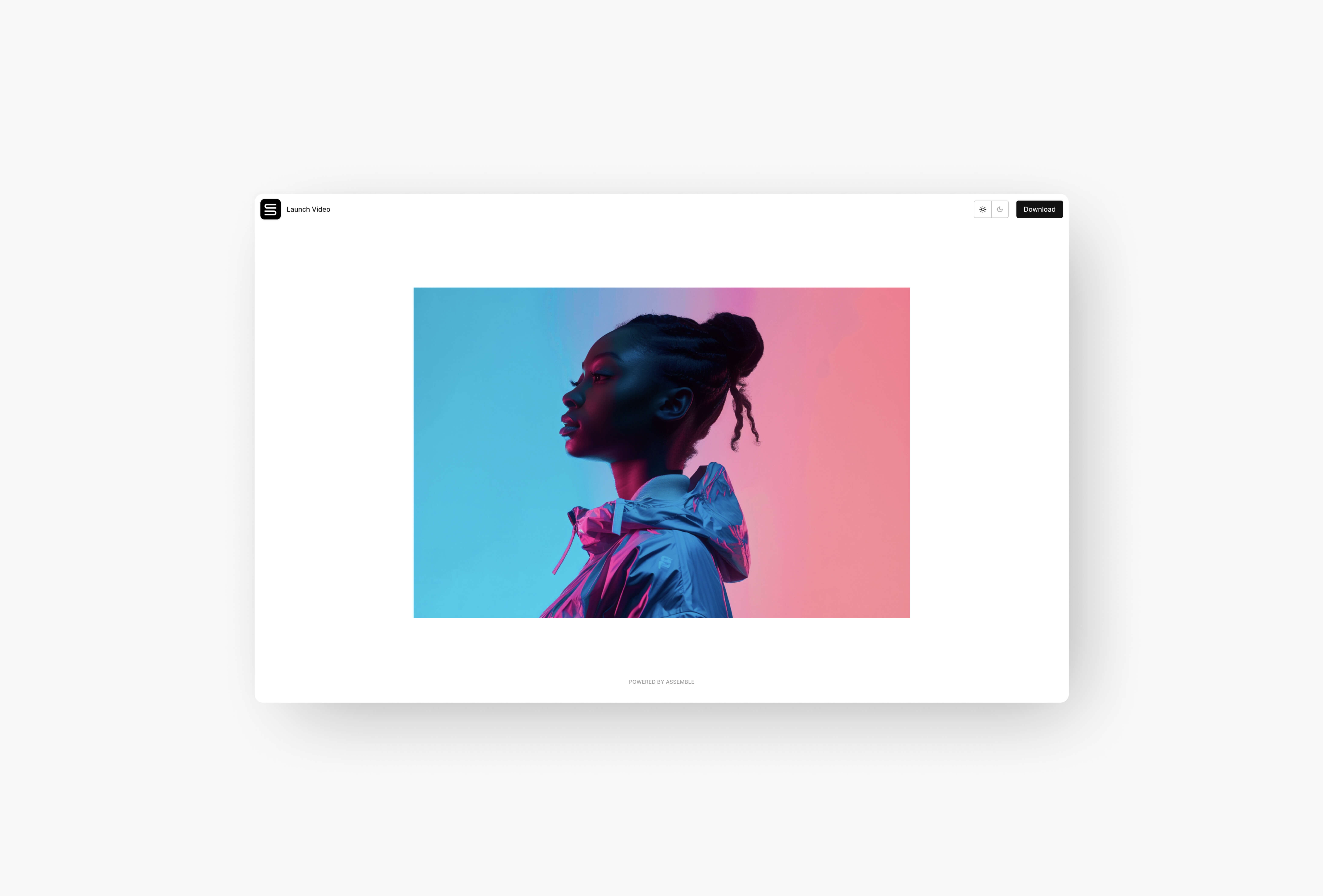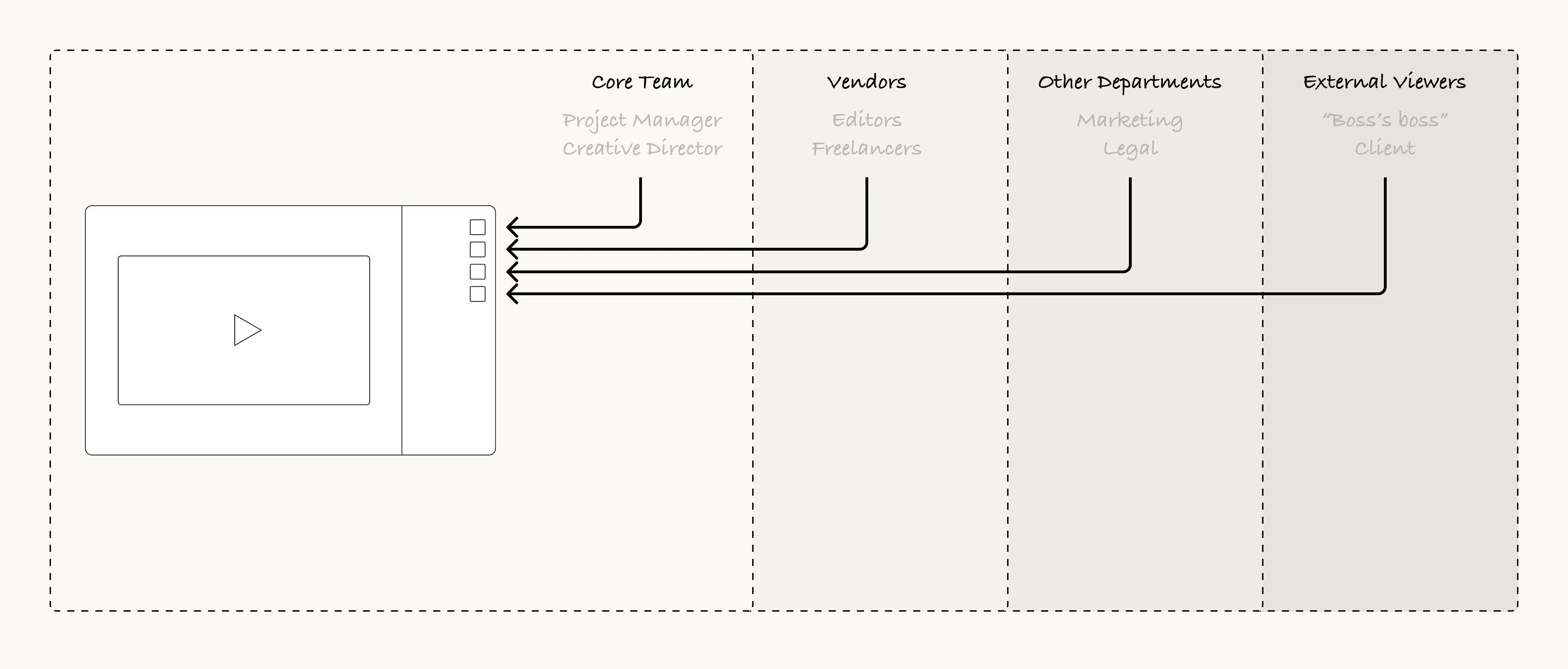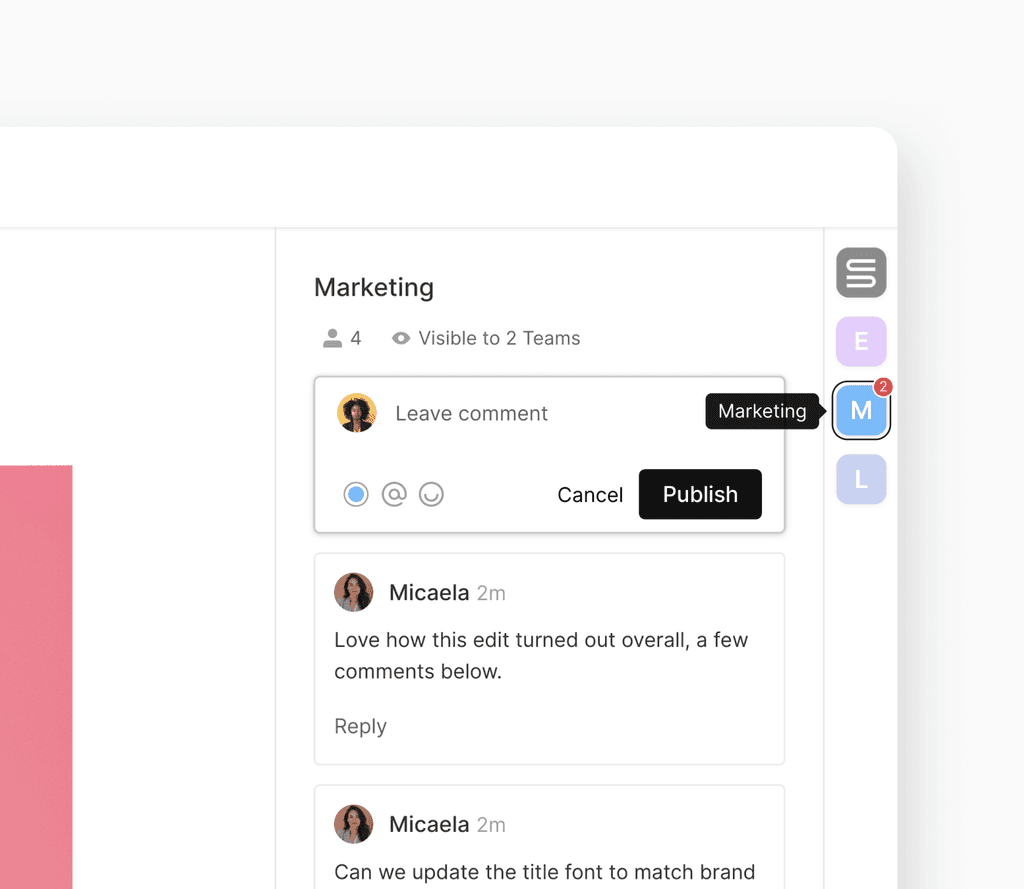Assemble
Solving the human factor in creative feedback cycles and increasing new leads by 70%
USER FLOWS, PROTOTYPING, USER RESEARCH, UX DESIGN
Live
01
01
01
THE CHALLENGE
THE CHALLENGE
THE CHALLENGE
Drobox and Google Drive had popularized file sharing long ago, and newer entrants were innovating in the video sharing space. However, our insights showed that these tools had overlooked the subtle nuances, psychological factors and emotions that exist within a creative workflow.
Managing the creative feedback cycle is complex, oftentimes including many different stakeholders (both internal and external) that need to provide feedback at different stages of the creative process. To further complicate things, due to human factors such as ego and social desirability bias, oftentimes you don't want these groups to be able to see eachother's feedback.
Drobox and Google Drive had popularized file sharing long ago, and newer entrants were innovating in the video sharing space. However, our insights showed that these tools had overlooked the subtle nuances, psychological factors and emotions that exist within a creative workflow.
Managing the creative feedback cycle is complex, oftentimes including many different stakeholders (both internal and external) that need to provide feedback at different stages of the creative process. To further complicate things, due to human factors such as ego and social desirability bias, oftentimes you don't want these groups to be able to see eachother's feedback.
Drobox and Google Drive had popularized file sharing long ago, and newer entrants were innovating in the video sharing space. However, our insights showed that these tools had overlooked the subtle nuances, psychological factors and emotions that exist within a creative workflow.
Managing the creative feedback cycle is complex, oftentimes including many different stakeholders (both internal and external) that need to provide feedback at different stages of the creative process. To further complicate things, due to human factors such as ego and social desirability bias, oftentimes you don't want these groups to be able to see eachother's feedback.


Various stakeholders who need to provide feedback
With current tools, users were solving this problem in a very clunky way. They would simply create duplicate versions of an asset, uploading the same file multiple times so that they could share the file with different groups of people and avoid communication crossover. When dealing with dozens of assets, this could result in managing hundreds of different links and trying to corral comments and approvals across all of them.
With current tools, users were solving this problem in a very clunky way. They would simply create duplicate versions of an asset, uploading the same file multiple times so that they could share the file with different groups of people and avoid communication crossover. When dealing with dozens of assets, this could result in managing hundreds of different links and trying to corral comments and approvals across all of them.
With current tools, users were solving this problem in a very clunky way. They would simply create duplicate versions of an asset, uploading the same file multiple times so that they could share the file with different groups of people and avoid communication crossover. When dealing with dozens of assets, this could result in managing hundreds of different links and trying to corral comments and approvals across all of them.


Duplication of asset versions for stakeholder groups
We felt confident that we could design a better solution to this challenge.
We felt confident that we could design a better solution to this challenge.
We felt confident that we could design a better solution to this challenge.

02
02
02
THE VISION
THE VISION
THE VISION
Our challenge was to create the simplest possible solution to a very complex problem. We envisioned a product-wide solution that would just work. Users should be able to set it up once and forget it.
After many rounds of wireframing, prototyping and user testing, we landed on an elegant prototype that resonated with our user base, which we called teams and layers.
First, we devised the concept of creating teams within your project. Teams would simply be different buckets of users that you wanted to segment based on role. Second, every file you uploaded would have layers for each team. Or to put it more simply, each team would have their own feedback channel where all of their feedback would be segmented within that file.
Our challenge was to create the simplest possible solution to a very complex problem. We envisioned a product-wide solution that would just work. Users should be able to set it up once and forget it.
After many rounds of wireframing, prototyping and user testing, we landed on an elegant prototype that resonated with our user base, which we called teams and layers.
First, we devised the concept of creating teams within your project. Teams would simply be different buckets of users that you wanted to segment based on role. Second, every file you uploaded would have layers for each team. Or to put it more simply, each team would have their own feedback channel where all of their feedback would be segmented within that file.
Our challenge was to create the simplest possible solution to a very complex problem. We envisioned a product-wide solution that would just work. Users should be able to set it up once and forget it.
After many rounds of wireframing, prototyping and user testing, we landed on an elegant prototype that resonated with our user base, which we called teams and layers.
First, we devised the concept of creating teams within your project. Teams would simply be different buckets of users that you wanted to segment based on role. Second, every file you uploaded would have layers for each team. Or to put it more simply, each team would have their own feedback channel where all of their feedback would be segmented within that file.


The concept of teams and layers within an asset


The teams concept in finalized UI
However, privacy was of the upmost importance. And for a variety of reasons, users didn't want teams to be able to see each other's feedback. So we designed a simple rule that enables the admin team to see all feedback threads, whereas guest teams are only be able to see their own feedback thread.
Admin users also have the ability to share comments from one feedback thread to another, enabling cross-team communication if needed, but only under the guidance of an admin user.
However, privacy was of the upmost importance. And for a variety of reasons, users didn't want teams to be able to see each other's feedback. So we designed a simple rule that enables the admin team to see all feedback threads, whereas guest teams are only be able to see their own feedback thread.
Admin users also have the ability to share comments from one feedback thread to another, enabling cross-team communication if needed, but only under the guidance of an admin user.
However, privacy was of the upmost importance. And for a variety of reasons, users didn't want teams to be able to see each other's feedback. So we designed a simple rule that enables the admin team to see all feedback threads, whereas guest teams are only be able to see their own feedback thread.
Admin users also have the ability to share comments from one feedback thread to another, enabling cross-team communication if needed, but only under the guidance of an admin user.

Admin Team View
Admins can jump in and out of all feedback channels, joining the conversations of all teams.

Guest Team View
Guest teams can only view their own channel, ensuring they don't see feedback of the other teams.

Admin Team View
Admins can jump in and out of all feedback channels, joining the conversations of all teams.

Guest Team View
Guest teams can only view their own channel, ensuring they don't see feedback of the other teams.
Lastly, we needed a way to share assets with external users who did not have an account. For example, if one of the guest teams needed to share it with their boss's boss for approval. For this, we implemented the ability to share any asset as a public review link so that users could view and leave feedback on assets with no account required.
When a review link is created, a new channel for the review link is created within the asset, just like a team channel. All feedback from that review link is funneled into this channel, and kept separate from other team channels.
Lastly, we needed a way to share assets with external users who did not have an account. For example, if one of the guest teams needed to share it with their boss's boss for approval. For this, we implemented the ability to share any asset as a public review link so that users could view and leave feedback on assets with no account required.
When a review link is created, a new channel for the review link is created within the asset, just like a team channel. All feedback from that review link is funneled into this channel, and kept separate from other team channels.
Lastly, we needed a way to share assets with external users who did not have an account. For example, if one of the guest teams needed to share it with their boss's boss for approval. For this, we implemented the ability to share any asset as a public review link so that users could view and leave feedback on assets with no account required.
When a review link is created, a new channel for the review link is created within the asset, just like a team channel. All feedback from that review link is funneled into this channel, and kept separate from other team channels.


Segmentation of review links comments from the admin view

03
03
03
THE RESULT
THE RESULT
THE RESULT
The result is a simple solution that solves a complex user pain point. With this feature, a user only needs to upload one single instance of an asset for collaboration with multiple groups of stakeholders.
Everyone views the same asset, yet the comments are all segmented into their own feedback channels automatically. Review links can also be shared out to gather feedback from external users.
All of the feedback, versioning, and approvals happen in one place, without ever needing to leave this single instance of an asset - from first review to final delivery.
The result is a simple solution that solves a complex user pain point. With this feature, a user only needs to upload one single instance of an asset for collaboration with multiple groups of stakeholders.
Everyone views the same asset, yet the comments are all segmented into their own feedback channels automatically. Review links can also be shared out to gather feedback from external users.
All of the feedback, versioning, and approvals happen in one place, without ever needing to leave this single instance of an asset - from first review to final delivery.
The result is a simple solution that solves a complex user pain point. With this feature, a user only needs to upload one single instance of an asset for collaboration with multiple groups of stakeholders.
Everyone views the same asset, yet the comments are all segmented into their own feedback channels automatically. Review links can also be shared out to gather feedback from external users.
All of the feedback, versioning, and approvals happen in one place, without ever needing to leave this single instance of an asset - from first review to final delivery.






